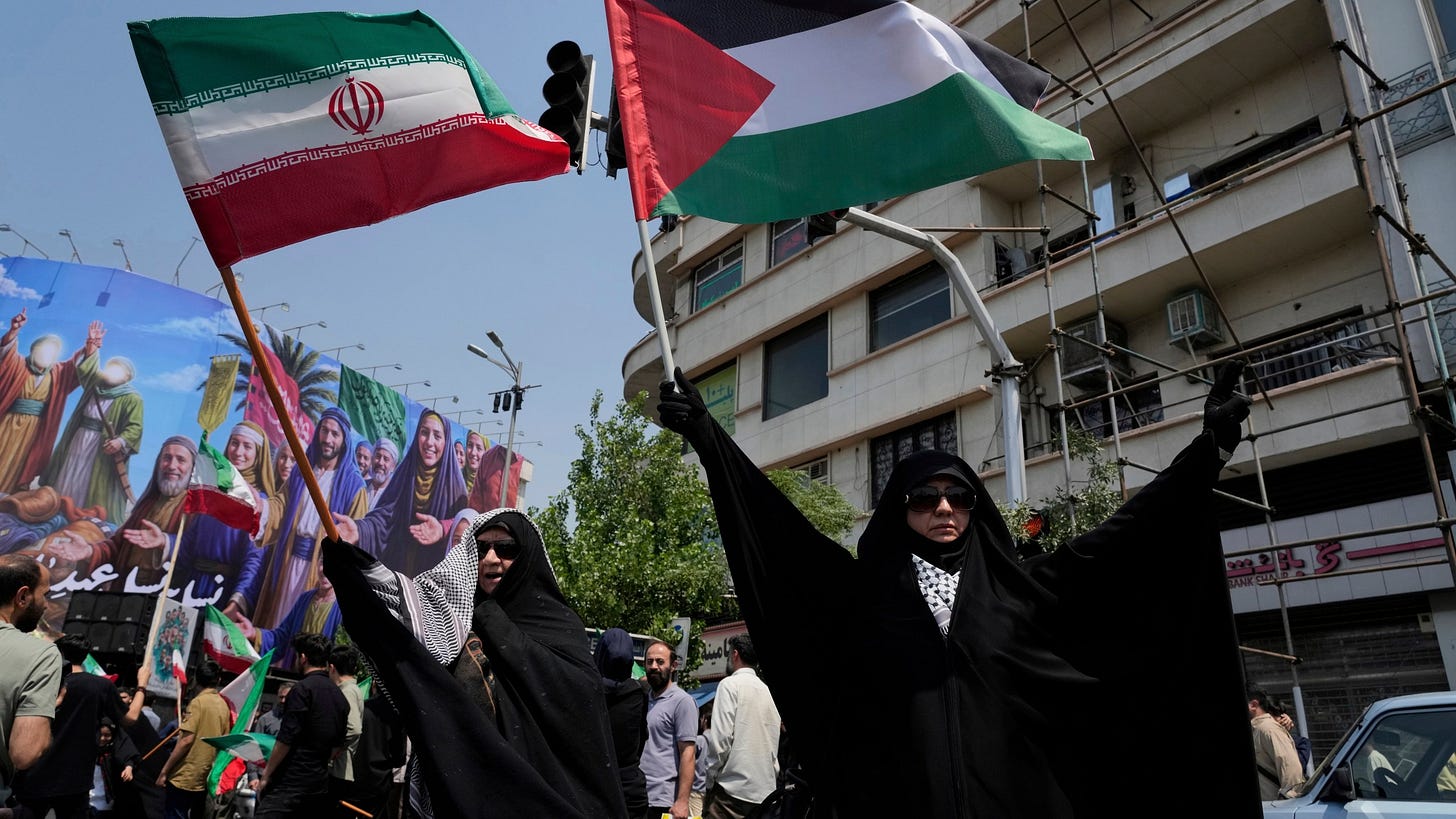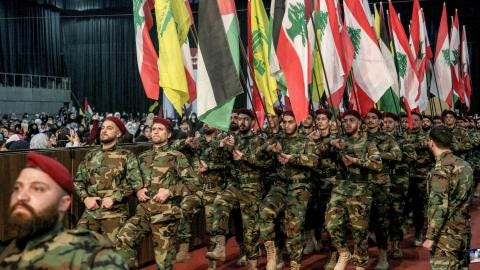Allies, Not Puppets
Understanding the legitimacy of the movements that the U.S. and its allies want you to dismiss.
🎧 Prefer to listen? The full audio read is above.
The bombs have fallen. The sanctions are still in place. And the story is already being written.
The headlines tell us Iran is the threat. That Hezbollah is a proxy. That the Houthis are pirates, rebels, or Iranian pawns. That Gaza is run by terrorists. But behind these labels are movements with deep roots, real legitimacy, and a shared position in the global order: they resist the domination that others accept.
In my last essay, I argued that Iran is being targeted not because of its theology or nuclear program, but because it remains sovereign over its economy, military, and foreign policy in a world where independence is punished. But Iran’s defiance doesn’t stop at its borders. It has used that sovereignty to support others who refuse to kneel.
That’s what scares the U.S. and Israel. Not just Iran’s defenses, but its alliances. Not just its oil, but its role in sustaining a regional structure of resistance.

These Movements Didn’t Start With Iran
The common narrative is that Iran supports resistance groups like Hezbollah, Hamas, or the Houthis out of blind hatred of the “free world.” In reality, it supports them because they resist Western capitalist domination.
This is a strategic decision rooted in history. After the 1979 revolution, Iran was isolated, sanctioned, and surrounded by hostile powers. Building alliances with other movements resisting U.S. and Israeli power was essential for survival. These groups became part of a regional bloc that pushed back against imperialism, economic extraction, and settler colonialism.
Western media and governments reduce them to “proxies,” a word meant to erase their legitimacy and flatten their politics. But these movements emerged from real conditions, with real support among people who saw no other path forward. Hezbollah grew in response to Israel’s brutal occupation of southern Lebanon. The Houthis mobilized against foreign-backed dictatorship and Saudi bombing campaigns. Hamas built support by providing social services and resisting the occupation, earning popular support before winning the 2006 elections.
These are not puppets. They are products of their people’s material circumstances. Iran may arm them, fund them, or help train them. But the U.S. does all of that, and more, for its allies. Including governments like Saudi Arabia’s, which brutally repress dissent, deny basic rights, and enjoy full diplomatic support. Many of these regimes have little popular legitimacy of their own. The difference is that the aims of the Axis of Resistance conflict with the interests of Western power.
Allies by Necessity
What ties these groups together is that they fight back, and in many cases, they’ve won.
Hezbollah formed after Israel’s 1982 invasion of Lebanon. It began as a small Shi’a militia and grew into one of the most formidable non-state actors in the world. In 2000, it forced Israel’s withdrawal from southern Lebanon. In 2006, it held off one of the most advanced militaries on the planet in a war that Israel expected to win in days. Today, it functions as both a political party and a military deterrent.

The Houthis emerged from decades of marginalization in northern Yemen. After surviving a brutal Saudi-led war backed by U.S. weapons and intelligence, they’ve done what no other group in the region has in recent years: they disrupted global shipping, targeted economic chokepoints, and forced major powers to take notice. The movement behind them predates Iranian support and extends far beyond its militant wing.
Iraqi militias have a long and complex history. Some formed to resist the U.S. occupation. Others emerged in the fight against ISIS. Today, many of these groups are officially integrated into Iraq’s security forces. Their ties to Iran are practical, a hedge against both foreign invasion and domestic collapse.
In Gaza, armed groups like Hamas and Islamic Jihad face annihilation with no air force, no navy, and no real army. For decades, the population has been starved, bombed, and besieged. Iran has supplied what little they have to resist the region’s most technologically advanced military.
None of these groups chose violence as a first resort. They turned to it after diplomacy failed, after being excluded from political life, after their people were bombed, occupied, or sanctioned. What connects them is a shared material condition of facing annihilation and refusing to accept it.
The Stakes of Legitimacy
Western media frames these movements as irrational, fanatical, or evil. But the question isn’t “Are they violent?” It’s “What created this violence?”
Because violence is everywhere in this system. The U.S. rains missiles from drones. Israel demolishes neighborhoods with U.S.-made bombs. Entire economies are strangled through sanctions. This kind of violence is accepted. It’s legitimized. Distant. Treated as the natural right of powerful states.
The violence of resistance looks different. It’s unsanctioned, improvised, and often desperate. But it’s also targeted at systems of occupation, extraction, and control. The fact that it isn’t blessed by the Western world doesn’t make it illegitimate. It just means it threatens the global order they serve.
When groups like Hamas, Hezbollah, or the Houthis are labeled “terrorists,” it’s because of what they refuse. They reject permanent subjugation. They challenge U.S. military dominance. They defy Israeli apartheid, oppose the Saudi monarchy, and IMF control. And they disrupt the flow of capital, weapons, and power that holds the system together.
The truth is, if these groups embraced that system: normalized ties with Israel, welcomed foreign troops, and opened their economies to Western capital, they would no longer be enemies. They’d be called partners. Their repression would be forgiven. Their violence would be reframed as security, stability, or even peacekeeping.
You can see it in real time: Israel’s bombing of Gaza is described as defense. Saudi airstrikes on Yemen were framed as regional security. U.S. and Israeli strikes on Iran are called “preemptive.” But when resistance groups act first, or retaliate after being attacked, they’re labeled terrorists.
It’s not violence that disqualifies these movements; it’s refusing to serve the system of extraction and control.
Not Just Resistance, But Survival
We don’t need to romanticize armed resistance to understand why it exists or why it matters.
These groups are marked by internal contradictions and legitimate critiques. Some uphold patriarchal norms. Some are shaped by sectarian histories. Some impose harsh discipline on internal dissent. And all have committed acts of violence that are rightly condemned. But so have the states that oppose them, often on a far greater scale. The forces they resist are real: occupation, siege, exploitation, and annihilation.
It’s easy to criticize the contradictions of the resistance. It’s harder to explain how any movement survives decades of war, sanctions, blockades, and constant assassination attempts without making tactical compromises. Many liberation movements have collapsed under far less pressure. These groups haven’t. That demands material analysis, not moral dismissal.
Iran has helped these movements, and the communities they support, not just resist but survive.
In Lebanon, Iran has channeled support through Hezbollah to fund hospitals, schools, power infrastructure, and reconstruction projects in the wake of Israeli bombings. In Gaza, it has helped finance tunnel networks used to transport medicine and supplies under blockade, and supplied fuel and cash transfers when international aid dried up.

In Yemen, Iran has supported the Houthis with fuel shipments, weapons, and missile technology used to deter Saudi airstrikes and break the naval blockade that has starved civilians. In Iraq, it has backed militias that not only fought ISIS but also helped fill the vacuum left by a collapsing state: providing security, rebuilding infrastructure, and organizing social services.
The Left and the Axis of Resistance
Iran’s support goes beyond weapons and training. It has made survival possible. And that survival is one reason the U.S. and Israel have spent decades trying to destroy the Islamic Republic.
The left must learn to analyze resistance not as isolated violence, but as part of a global structure of domination and survival. These groups are not isolated actors. They are responses to imperialism, shaped by the material conditions of their communities and the violence imposed on them. They reflect what was taken and how people have fought to reclaim it.
A focused essay on Hamas is next, not to celebrate, but to understand: how it rose, why it governs, and what it means to resist under occupation. But before that, we need to make something clear:
These movements do not exist in a vacuum. They are not proxies or pawns. They are people who have refused to bend the knee.
Understand the world. Change the world.
You’ve read this far for a reason.
You’re not here to be comforted; you’re here because something isn’t adding up.
Let’s figure it out together.
Weekly essays from Concrete Analysis.
Direct. Unapologetic. Grounded in reality.
This piece made you think? Help others see it too.
Share this piece
Further Reading
These works offer deeper political grounding for understanding Iran’s alliances not as acts of aggression, but as efforts to support resistance in a system that punishes defiance. They are divided into liberal critiques that expose how these groups are framed and targeted, and Marxist foundations that explore the roots of popular resistance, legitimacy, and survival under siege.
Liberal Critiques
Hezbollah: A Short History by Augustus Richard Norton
An accessible but serious introduction to Hezbollah’s origins, political development, and dual role as a resistance force and social provider in Lebanon.The Forever War by Dexter Filkins
Though written from a Western journalist’s perspective, this book offers firsthand reporting on Iran-backed militias, U.S. military occupation, and insurgency dynamics in Iraq — helpful for understanding the post-invasion environment that gave rise to many resistance groups
Marxist Foundations
Revolution and Disenchantment by Fadi A. Bardawil
Explores the legacy of Arab Marxism through the lives of revolutionaries grappling with the limits of armed struggle, anti-imperialism, and political compromise. A sharp and honest reckoning with the contradictions of resistance in the Middle East.Border and Rule by Harsha Walia
A sharp structural analysis of how states manage dissent and resistance, including frameworks for understanding why some violence is legitimized and others demonized.
Up next: “Hamas and the Right to Resist” drops Tuesday, July 2 at 11 AM.
Subscribe to be notified when it goes live.
If something in this piece resonated or challenged you, I’d love to hear your thoughts in the comments below.




Would love to hear what people thought of this one. I know it’s a controversial topic, but these groups are central to U.S. propaganda. That’s exactly why we have to reframe them.
Curious where others land on this.